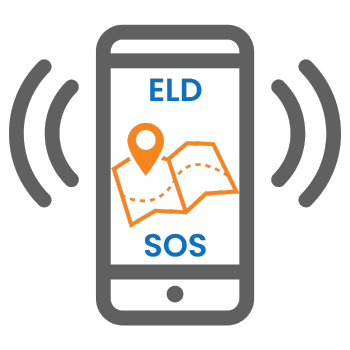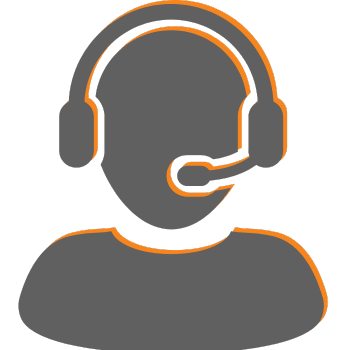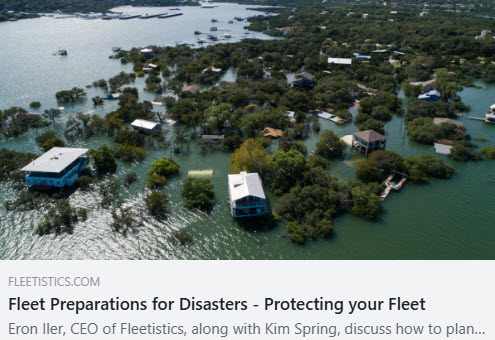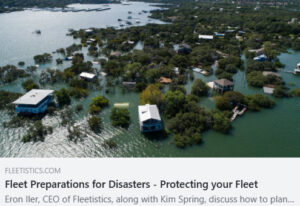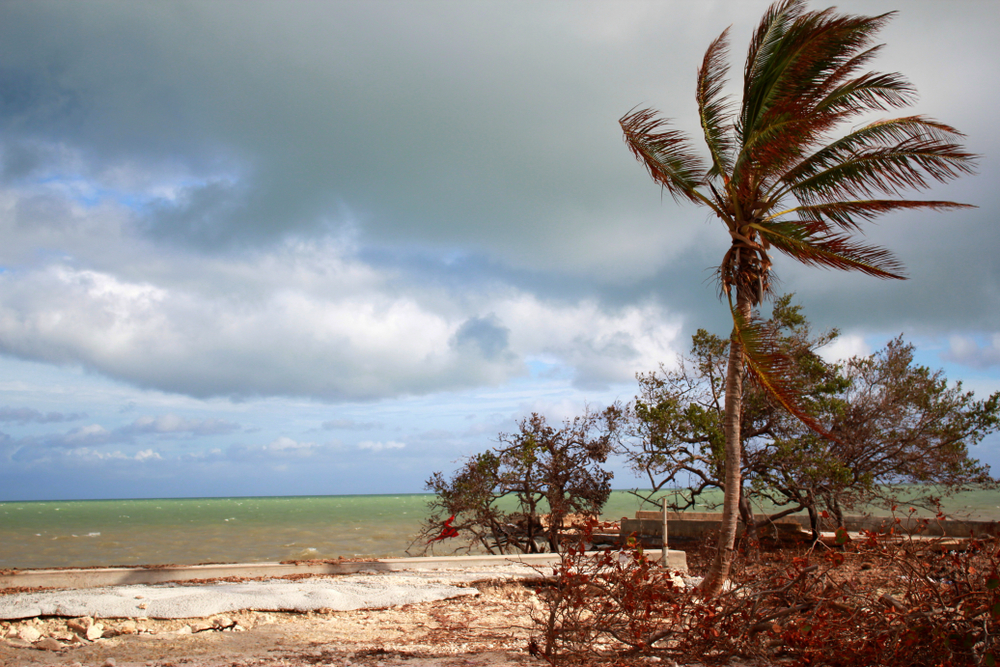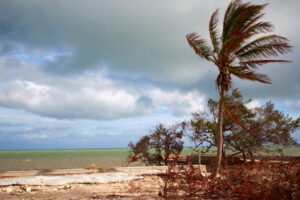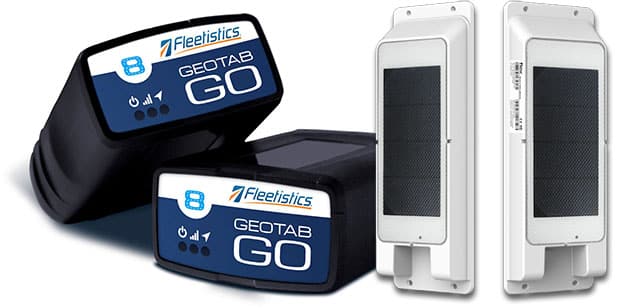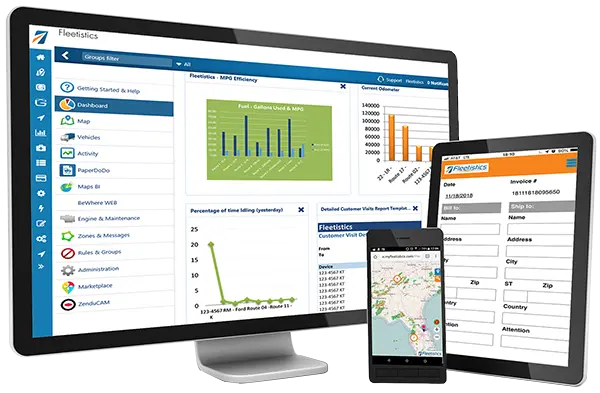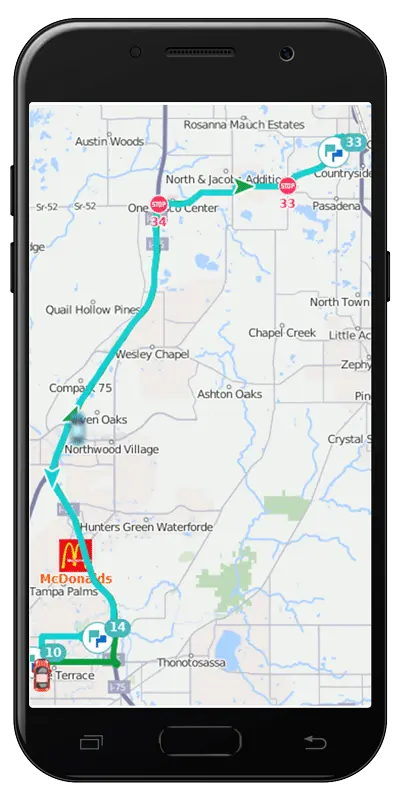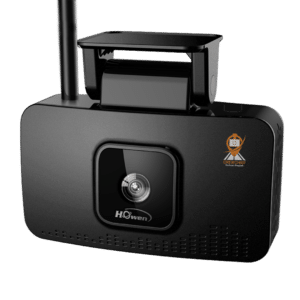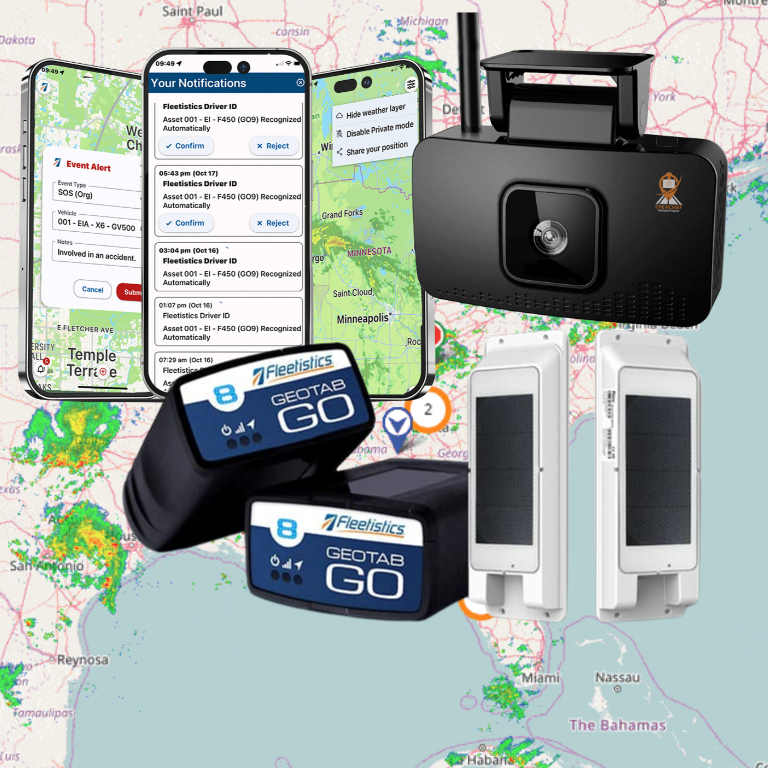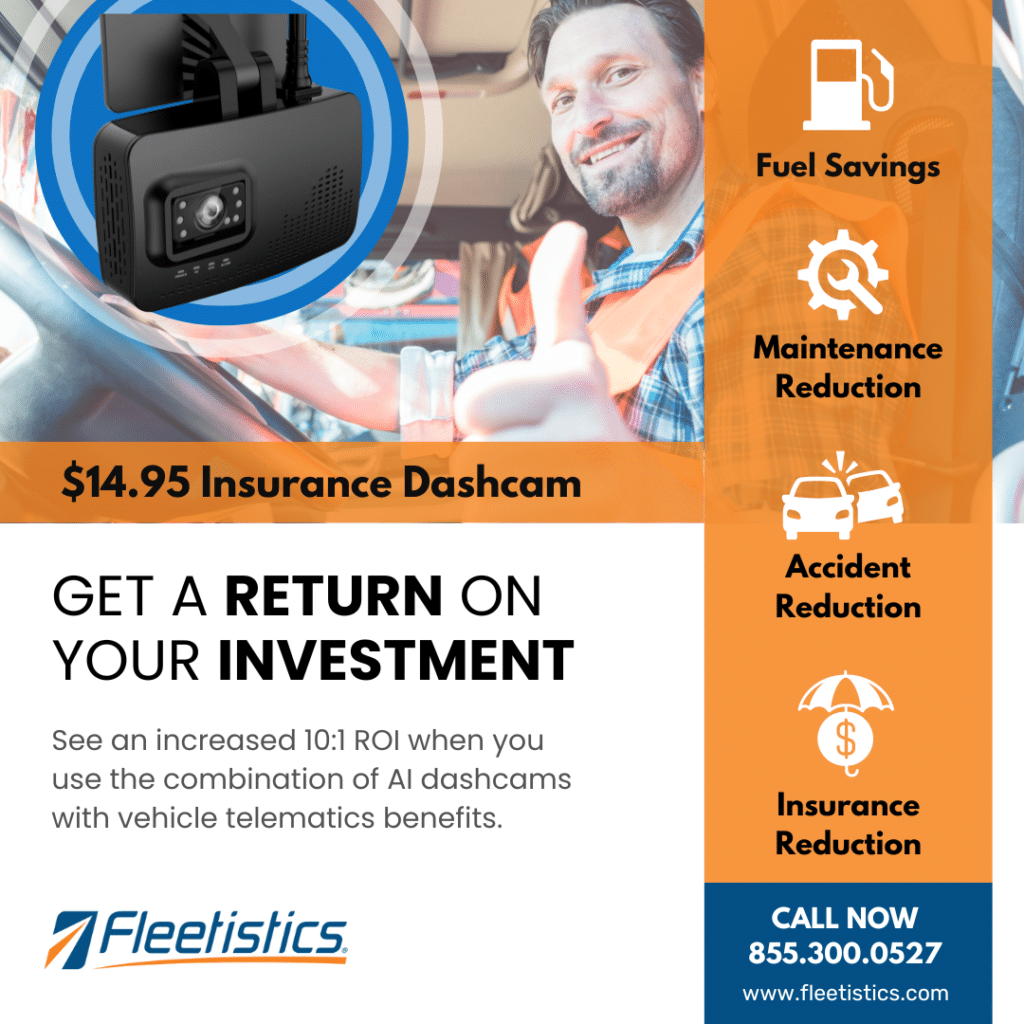Fleet Disaster Preparation Transcript – Introducing Our Hosts
Hey everybody.
Eron from Fleetistics and then today I’m here with Kim Spring who has been with Fleetistics for how many years now Kim 15 years and in the Telematics business for 22 and Fleetistics has been around for 23.
So only one more year than Kim has been in the industry, probably almost identical I would think we’re probably late 22 years, early 23 years.
So, we’ve got quite a bit of experience here and all this experience really comes from the state of Florida which is where we are home based.
Over those decades of doing this, we have been through multiple hurricanes, right. And Kim, you were just recently involved in Hurricane Michael because you live South of Tampa and that’s where Hurricane Michael, correction, Hurricane Ian actually landed and was quite devastating.
And Kim lived through that matter of fact. I drove down to see Kim shortly after because we lost communication with Kim and I had to drive through three feet of water to get to Kim’s house, which was like an island, you know, in this flooded area. Fortunately, everything was OK.
A Storm is Brewing…Where do you start?
So, you know, it really kind of brought up this whole idea that, you know, we’re getting into hurricane season. And you know, as a fleet operator, what are the things that you need to be thinking about in the event that you can see a hurricane coming and the steps that you can be taking kind of in preparation for that?
What you don’t want to do is get caught at the last minute and you see the hurricane coming up the Gulf and all of a sudden you decide you want to make a hurricane plan and you don’t know what to do.
So, we’re going to give you some tips and probably some real stories about things that that happen out there based on real experience. So, let’s go ahead and get started. And Kim, any comments before we jump into the other stuff?
No, I think it’s important to have a discussion like this because we’re geared towards the fleet industry and fleet disaster preparation is going to be different than your house preparation.
So, you know, please take into consideration some of these tips. Hopefully they can advise you in some positive business manners, yeah.
Preparing your Business and Assets
I think the mindset of preparing your fleet also kind of puts you in the mindset of preparing your business, right. At Fleetistics, we have been running Microsoft 365 since it came out basically, right.
We’ve always been on that platform because if our business ever got hit by a hurricane, we had the mindset that we will be able to pick up and walk away from our desk anywhere, anytime and go to someplace else and go to work and not miss a meet with our customers.
And that’s really the mindset that you should be thinking about not only with your fleet because you have to use those vehicles to deliver products and services, but you also have this whole back office that you have to consider as well. So that’s another video for another day with other considerations.
But you know if you’re in this planning process then you know, consider that whole thing as well and how you can tie those two things together. That’s actually one of the points that we talking about today is you know, how do you process orders, right?
How do you collect money? What do you do with it? How do you take payments? You know, the power’s out. Are you out of business or can you find a way to function? So, we’ll get into that.
You know, as we, as we look at this, there’s a couple things to try to obviously to mitigate the impact on your fleet. And if you were to lose your fleet, you’re out of business, right, it may be because everybody in your area is going to be looking for trucks or vehicles at that time, right?
And you will probably be able to get some vehicles maybe in a couple weeks from Wisconsin or something if you’re in Louisiana. But you’re going to be missing a lot of revenue.
You’re going to have people that aren’t getting paid that are going to be looking for work that may go find work and not work for you anymore because they need income and things like that.
So, you know, having a good plan to not lose your fleet to begin with is step #1 and #2 is your insurance, right? What’s going to happen to your insurance premiums?
We all know insurance is there, but they don’t lose money. At the end of the day, your premiums are going up. You’re going to pay one way or the other.
You’re going to buy those vehicles either through your premiums or some other way. So, it’s best not to have to file a claim if you can avoid it at all. And then your customers too.
I mean, you know, if you’re not delivering service, I’m thinking like you know, pest control company for whatever reason or you know lawn care, landscaping, you know those types of businesses, service companies and you’re not out there delivering service, they’re going to go to somebody else, they’re going to call somebody else.
If the HVAC isn’t working and you can’t deliver service, but your competitor can, now you’re losing that customer’s going to shift because that business was there during this time of hardship, and you weren’t.
So, they may keep your customer indefinitely, which you’ve worked very hard to get and make happy over the years, but now you’ve lost because of this one instance. And we all know how quickly customers will go from point A to point B to get service right.
I think two other things that you have to think about is one is you have to take care of your people. You know, people need paychecks. They’re going to have their own expenses if you get hit by a bad storm. And this could be a, this could be a hurricane, right?
That’s our frame of reference because we’re in Florida, but it could be a giant snowstorm that tears things apart. It could be flooding. I mean, the West Coast has had terrible flooding this year, could be wildfires, whatever those things are.
You’ve got to have this mindset of being prepared to address these different scenarios that may be coming about, and you may be in some in some areas that could be potentially affected by all or multiple, you know, types of events. You need different plans for different scenarios.
And then you know the other thing about being a business owner is you have to protect your future and what are you going to do for you or for yourself.
You as the responsible party for the people that work within your organization, you’ve got to figure out how to take care of everybody, because if you can’t function, your people can’t function either, right?
So, we’ve got lots of good reasons why being prepared is super important to everybody that’s associated with the organization. All right. So, let’s look at our tips.
Pre-Storm Preparations
So, the first tip that we have is when you know something is going to happen, fill up your fuel tanks.
So, tip #1, fill up your fuel tanks. And this could be just your vehicles, but it also could be bulk fuel that you may have on site. Where was I? I was at a construction company not too long ago and I was also at a government agency, and they had bulk fuel.
And making sure that your bulk fuels topped off is important. But when you have bulk fuel, you also have to be able to run the pump, right?
So, you got to have electricity or a hand pump of some sort. So, you have to kind of think that through. You won’t be able to buy a hand pump at the last minute because everybody’s going to need one.
But you know, having a generator or something of that nature or even potentially running the pump off an outlet on the truck that could potentially work, or you know, hook it up to a tractor for power while you pump your fuel into your vehicles. So, you know, things of that nature, I guess diesel versus gasoline.
Did you experience anything during Hurricane Ian that was well, one tip regarding that, do not wait till the last minute. Everybody’s rushing out to do it. You got every citizen out there.
You have other businesses. So, if you have the ability to have on boards, you know, storage at your facility for it, make sure that you at least keep that topped off.
That’d be #1 and #2 definitely as soon as you can get them and keep them fueled up. If you know that storm is coming, just keep having them top it off until the time comes. And if at all possible, you know, let the vehicle, you know, if you have a safe place to store it, that’s perfect.
But you know, just in preparation for the incoming storm, don’t wait till the last minute. It’s the worst possible scenario because they all ran out when we got hit by Ian, everybody. All the tanks were out, all the gas stations just weren’t able to assist.
We didn’t have power for about a week and ½. So don’t wait the It’s like people, people buy a bottled water all of a sudden at the last minute, it’s like there’s not enough water to go around and everybody waits the last minute for some particular reason.
When water’s something you can buy a month in advance and have it, fuel not, you know, it’s a little bit more consumable. Yeah, we felt that crisis during COVID. Everybody did toilet paper and water. I would say make sure that you order fuel too, right.
If you have fuel delivered to your location, place an order to at least get on the schedule. So, you know, maybe a week after the event you’re already on schedule.
People that weren’t thinking about that are going to be placing orders and they’re going to be behind you instead of in front of you. You don’t want to end up not being able to get fuel for two weeks, right? So that’s a that’s a big deal.
The importance of extra inventory and supplies
All right. So tip #2, order a little extra inventory. So if you do things like fertilized lawns or pest control or roofing, especially roofing, right. For hurricanes.
Yeah. Or extra inventory, because you’re going to need it and you’re not going to be able to get it. When we were doing one of these videos last year, there was a chip shortage, right? The idea of even getting a vehicle after, you know, one was lost.
It was like, oh, you’re going to have to wait a year and a half. But you know, you need to be thinking about what are the consumables that you’re going to need that you may not be able to get because again, if a customer calls you or you have scheduled service and you can’t do that service and they potentially go to somebody else, now you’ve lost a customer because you didn’t have a $5 bag of fertilizer or whatever the case is, right.
Yeah, that that was something that my husband, or, his company experienced, and they were actually ahead of the game because of what you’re saying. They are in the low voltage industry. So, they’re dealing with alarm systems and they’re dealing with the theater systems.
They need a lot of CAT5, all this extra cable. Well, they made sure they had extra on hand in the event things went down. They had to go out repair alarms, especially that when the hurricane hit in the southwest region of Florida, it was, you know, it was not snowbird season.
So, all the northerners had gone home. So, their homes were left, they couldn’t get to them in time. So, a lot of those types of companies were going out and servicing to make sure and check through system. So having that extra inventory is definitely key.
And when you think about the devastation that takes place during a major hurricane like Ian, where it came ashore, I mean, water was 12 feet in the air.
I mean, it was just, you know, catastrophic buildings that are important buildings, you know, some are completely destroyed. There’s no point in having an alarm and there’s nothing to steal anymore.
But if you’re on the fringes of those areas and you take a lightning strike or something like that, you want to get that back up and running. So, you know there’s no looting going on that you don’t know about in your store.
So just a great example of that inventory allows them to get to work very, very quickly where everybody else won’t be able to get to work because we don’t have that inventory.
Protecting Company Assets
All right. Tip #3, parking your vehicles in an area that protects them and this is actually a multi part tip, you know with wind, with wildfire would be another one that’s very devastating. Flooding is kind of an event that wrecks vehicles completely.
You’ve got to think about where to park your vehicles. So, you know they’re obviously protected if you’re in a low area. And Kim, I think Eric’s, or Eric’s office actually got flooded. But where were the vehicles parked?
The vehicles were parked, well, one of them was parked in the facility and it did make it out alive, but the actual warehouse did flood. They have sensed move locations, but yeah, there’s a lot of very low-grade areas and there are flood zones.
So, the recommendation is to bring those vehicles high, park them in, if you know, the Walmart parking lot is full, park it close to the building, keep it away from, you know, flying debris. That’s the biggest thing that kills them.
You know, you’ve got all kinds of flying debris that’s going on out there during one of these catastrophic storms. So that’s one key.
If you have a great protected warehouse, you’re in a good situation as long as it’s not in a flood zone, right? Right. And fallen trees are another big one. I mean, one tree would take out four or five trucks if it’s a big enough tree.
So, wherever you go look up to see, you know, do we have power lines, do we have trees? Do we have trees with dead branches on them?
Do we have trees like, one big pine tree above the forest in the area that you know is going to be taking a tremendous amount of wind compared to the other ones?
I did drive through northern Florida after Hurricane Michael, which is what hit, you know, South of Tallahassee area and it was just amazing for miles. Every pine tree along the route was broken off at the same height.
It was just like someone took a knife and just cut all the trees off the top and it was just acres and acres of trees laid down pointing the direction the wind was blowing. So, you know, trees are definitely a big, big issue.
The other thing is parking, a configuration that allows one vehicle to protect another. You know, if you’ve got 30 vehicles, you don’t want to park them all. So, they’re all facing the same direction and they’re all kind of exposed the same way.
You know, you might park your cheaper, older vehicles around the outside, so they take the brunt of the impact of debris. It could be rocks from your parking lot or whatever the case is.
But, you know, sacrifice a few vehicles, and take the beating and keep your best vehicles in the best shape.
Mitigating risk for everyone
Let’s see. So, remove loose items. We are at pest control company, you know a couple weeks ago and there’s a lot of things outside. The neighbors had lawn; they were a lawn company like a whole wholesaler.
And they had yeah, they were lawn mower the, the industrial lawn mower, repair shops. So, there were pieces of things everywhere, right.
All those things are debris that’ll penetrate windows, punch through doors, you know, destroy things. So, make sure all that stuff gets picked up.
One of the things to consider is you know you are better off sending vehicles home or home with the drivers, right? You know, if you’ve got AGPS tracking system in there and that reminds me of the fuel thing, you know, we can track the fuel level in the fuel tank, right?
So, if you’ve got guys that are running around starting to run their fuel tank level down when you want them to keep it topped off, you can actually see how much fuel they have in those tanks.
And you can say, hey, hey Kim, I see your fuel tanks are below half. You need to get it fueled up, you know, before the end of the day or something like that.
But you know, you can with GPS, you can send those vehicles home to the drivers and disperse your liability and your risk. If it’s a better program, you’ve got a way of keeping track of the vehicles where they are, making sure they’re not being driven, things like that.
And that way you know if you lose a vehicle or two, you’re not likely to lose the entire fleet if a, you know, if a storm was going to roll over your particular office. So that’s a good way of mitigating some of that risk.
Ensuring your employees are prepared and safe
Another thing to consider when you’re talking about that is not all the employees live in the affected zone per SE. Some may live 60 miles from the office, and they are going to be considered in a less, a less impact zone and your vehicle is potentially going to be safer with them than it’s going to be where the direction of the storm is. Yeah. And telematics finds some comfort.
If you have dash cams, obviously you can spot check, you know, so you’ve got the accountability piece to give you Peace of Mind that vehicles are going to be used correctly.
And it’s also something to consider that, hey, if it works out well, maybe that’s a perk that you want to offer to people, so they don’t have to drive back to the office at the end of the day and then drive their own vehicle home.
If you know that they’re going to be part of the vehicles and not using them after hours because of the technology you’ve invested in, they can go straight from the last stops home and now you’ve got happier employees.
So that’s something to look at. And you can also monitor battery level. That was another thing. During these types of events, making sure your vehicles are going to start, somebody doesn’t need the headlights on, you know, things like that.
All right. And the next tip is to hold a meeting to review the procedures. You can have all the greatest plans in the world, but if you don’t have a meeting to talk to the drivers and kind of communicate what your game plan is, share some information like, a one-page document that says, hey, this is the hurricane plan, here you go.
Or this is the Wildfire plan. Here you go. Here’s all the latest phone numbers that you need for managers and department heads and things like that.
And with the steps that you should be taking, the three to five things that we want you to do, IE, keep your fuel tank filled up, park in a safe location, make sure your vehicle is clear of inventory off the back, right.
You know, if you’re a plumbing company, you might have fittings all over the back of your truck that are just going to be gone, either stolen or fly off the back of the truck in a hurricane or could be melted in a wildfire, who knows.
But making sure that those types of steps are being taken, they’ve got written instructions. So, everybody’s on the same page with how things are going to be handled.
Keep your Customers informed and prepared
All right? Now, tip #5 is to communicate with your customers. If you have work scheduled, right? Let the customers know. Hey, we haven’t forgotten you.
We know it’s going to come. They’re already thinking, you know, hey, we’ve got a major hurricane rolling in. I’m not too worried about it, but hey, it was great to hear from you.
Thank you very much for contacting me. Take your time. Get to me whenever. All right, now you make a note. Customer says whenever. Schedule, reschedule them.
So, we’re not trying to do service right before a major event because people have to take care of their own houses and families too.
And yeah, there’s a lot of prep that goes into that just for people to be ready. And when people take care of their personal lives, they can give themselves more to the business after the fact, because they know everything at home is OK, right.
You know, when I came down to see you, we rode by one of your friends’ houses and they had, you know, a couple trees down and things like that, you know, that had to get cleaned up.
And yeah, under the circumstances we, we were very lucky considering we are on a canal and but we, we were much better than a lot of our neighbors were, because I’d say 75% of the area had some very significant damage.
I mean there you can still see some of it today and there’s still a whole lot of trees that only lean in one direction because of it. So, I know exactly what you’re talking about.
Yeah. So set those expectations with your customers, reschedule where you can loosen the schedule up. You know, try to try to just get on the same page with the customers so they’re not likely to leave you.
If you have some kind of campaign that you’re used to send a newsletter to everybody, just letting them know, because you know, in preparation for it.
It might be hard, depending on what your availability is, while people are also preparing employees or preparing their own homes for this storm.
That’s the easiest way to get the word out to everybody that they you might be affected by the storm. That’s a good idea.
And it also brings up what we do on our login page, right? We post messages up there if we’re going to be closed for a reason or if we have a technical issue, we can communicate with customers that way.
So even if we can’t get to the website after the storm because we lost power, we’ve shared that information before either in a newsletter or on the website or things like that, so customers have something to go reference. OK, all right.
So, we actually rolled tip #6 into tip #5, which is rescheduling your customers not packing things too tight, especially if you do like lawn care, right?
You know, once it starts to rain, it’s going to be wet anyway. So got little areas dry out before you can put any mowers in there anyways so.
Your EmploYees are Customers, too
All right, #7 is considering how to run your field operations if you don’t have power, right? Think about what that entails for the way that you use, you know, do business, and you may be using electronic forms.
You obviously have an Internet presence. You have communication, you have billing and processing that needs to take place.
So, what are the steps that you can take to begin to continue to be able to function? You know if you don’t have some of those, you know, the necessities. And we think about what are necessities.
We kind of go old school, right? And, if you’re around, as long as we’ve been around, you’d remember paper and pencil, you know, paper and pen, you know, used to do a work order by hand with three, you know, 3 copies on carbon paper.
So, you know, the little credit card machines that run through, but if you don’t have those things, you know, are you going to change your policy for a little bit that says, hey, look, we’re going to, we’re going to do hand orders, right?
We’re going to print them. This is what they’re going to look at, look like everybody’s going to get 20 because we do five services a day and we’re going to take checks for the foreseeable future until everything starts to come back online.
And then as soon as that process is over, you can go, you know, back to the old way of doing things. But it allows you to keep collecting money, which allows you to keep paying your people.
It keeps your customers happy, keeps your revenue flowing, you know etcetera, etcetera, everybody understands how that snowballs.
So, figure that part out, have a policy with your back office and your field technicians, add it to that one pager, set expectations, war game it together, you know everybody’s oh hey what about this situation or that.
And you kind of talk about it as a, as a group in the meeting, and you’ll come up with a lot of great ideas and everybody will get comfortable with this idea that we’re going to have to deal with, you know, these types of issues.
All right, Tip #8, Make sure that you can pay your people. So have a process for your payroll, right? If you can’t do bank deposits for whatever particular reason, the Internet’s down or what have you, how are you going to get people paid?
They still have bills to pay. They have to buy things, supplies, repairs, whatever. So, figure out how you’re going to get your people paid.
And are you going to be able to write them checks? Are you? How are you going to be able to do those calculations? Do you have to get a hotel room in another city, you know, where you can get an Internet connection?
You know, maybe you want to reserve a hotel room and just spend a couple 100 bucks, know what’s there. Even if you don’t check in, maybe you’ve got your name on it and you’ve prepaid for it, so they’ve got Internet and it’s outside the area.
You can move people there to function, if necessary, but you’ve got to figure out how to handle the most critical things, which are collecting money from your customers after you provide service and paying your people, right?
So, figure out a payroll process that would under duress speaking along those lines, being one of those employees, once I knew that things were right at home, I might I didn’t have Internet right away, but my cousin that was only 15 miles away did.
So, I made preparations to go over, basically steal his Internet so that I could still get my job done and get back to normal while things were going on. So, there’s always different preparations. You need to take both the employee and the business owner itself. So absolutely.
Know your SOS Processes
And then tip #9 is implement some type of SOS capability. You know, there’s times that people are going to be out. You know, post a major event, trees get weak, roads get washed out, roads get blocked, you know, all power lines are down.
It is a time where there’s a lot greater opportunity for some type of emergency to take place. And communication is going to be difficult because the Internet is going to be challenging the cell phones that are up are going to be challenging.
People will be sending photos and videos and talking all the time on their cell phones. So, it’s going to be more challenging. Some of the towers might be down, so there’s going to be congestion.
So, figure out how you can do something, you know, some kind of communication protocol that is very light in nature, doesn’t require a lot of data. Yeah. And yeah.
So, Kim’s holding up our CrewChief mobile app that has an SOS capability, which is that button at the top that’s in red. And when you hit that, it opens up this little window and you can punch some information in. Or if you can just hit send, it’ll actually notify multiple people.
They’ll text you, and they’ll e-mail you. And it’ll actually open up in the app that says, “hey look somebody in your area, another one of your coworkers is reporting an emergency of some sort” and you can get flagged that way.
So, if that’s something that you guys are interested in giving us a shout, we actually do a couple different things in the crew chief out now. But you know we call it a priority event. So, it’s not tied to 911.
So, we don’t want to call it SOS, but it’s a priority event that lets you know almost immediately if there’s been some kind of an emergency out there in the field.
And that actually brings up a good story that almost ended in disaster. I was cruising down to see you and I don’t know if I ever told you this, but I was cruising down to see you early in the morning after the storm, right?
And I was going down I-75, I think it was like 4:00 in the morning. There was probably nobody a mile ahead or a mile behind. So, it was black. All the streetlights were out. It was kind of, it was really kind of eerie.
And you know, I’m cruising along doing 70ish and I’m in the middle lane or maybe in the right lane. And I get to this area where the highway splits and there’s a bunch of trees in there in the middle.
Those trees started blowing onto the highway and there were a bunch of trees that were actually down laying over the left lane and partially in the middle lane.
And I can see the headlights behind me that were coming thinking those people are going to run smack dab into those trees and it’s going to be someone’s going to get killed, right.
I was fortunate that, you know I saw them because I was in that lane. So, I was able to back up and I went over. I actually had these LED lights that you know like roadside flares, electronic flares.
And I was able to put the put a couple of those in the road at least maybe help people slow down recognize there was some kind of problem before I actually got over there.
There was, there was an FWC officer, two of them in pickup trucks. One of them smashed into the trees and he made it through. He wasn’t all the way left. So, I think he swerved and hit like the branches and, you know, things were flying.
And the other one actually backed up to come see if I was OK, right? And I would say no, I’m just trying to get some flares out because this is a problem.
But that’s something that I would have never seen or never thought of without having that experience. And that’s the emergency stuff that you just don’t know that you don’t know until you’ve experienced it, because it’s you just don’t think about it. But absolutely. Yeah, interesting stuff.
In Closing
OK, All right. Well, we are done with tips for preparing for emergencies or some kind of disaster. Hopefully this is good information that’ll get you thinking about these types of things for your business and your fleet.
If you appreciated the content, please just hit the hit the like button down there. We’re going to do more of these types of things. We’ve got a lot of great videos on our channel, so you may want to subscribe and get alerted.
We try to put value added content out there, not just you know, marketing material all the time. So, subscribe if you’re interested and hopefully, we’ll see you on another video.
Thank you. All right, we made it, we did. That was pretty good. Yeah. It was fun. Those are so easy. Yeah.



